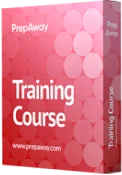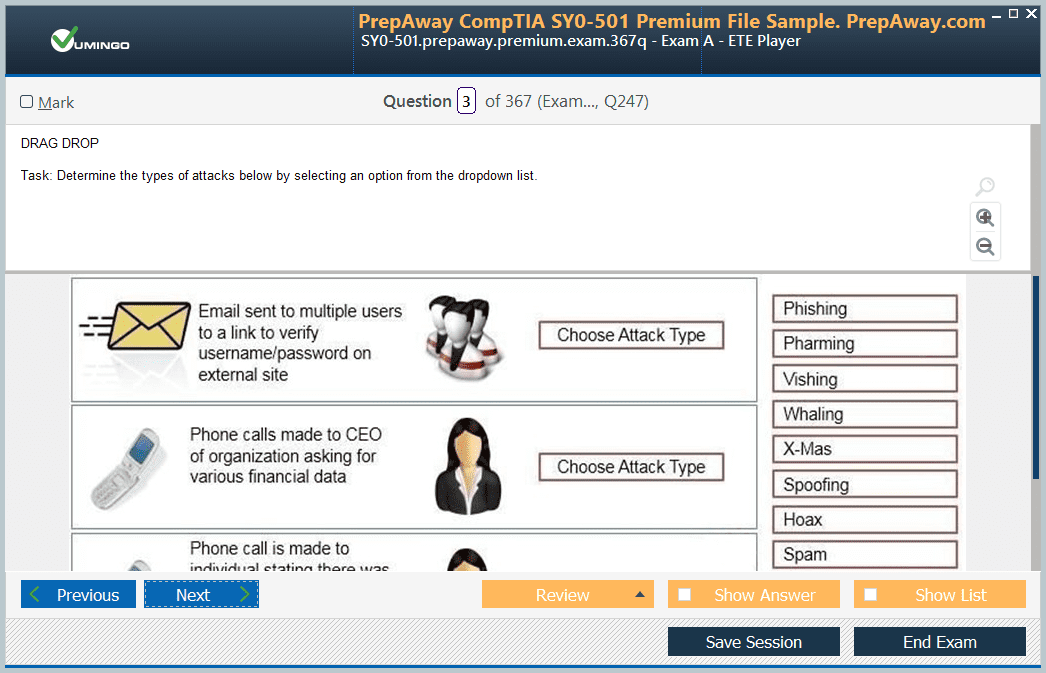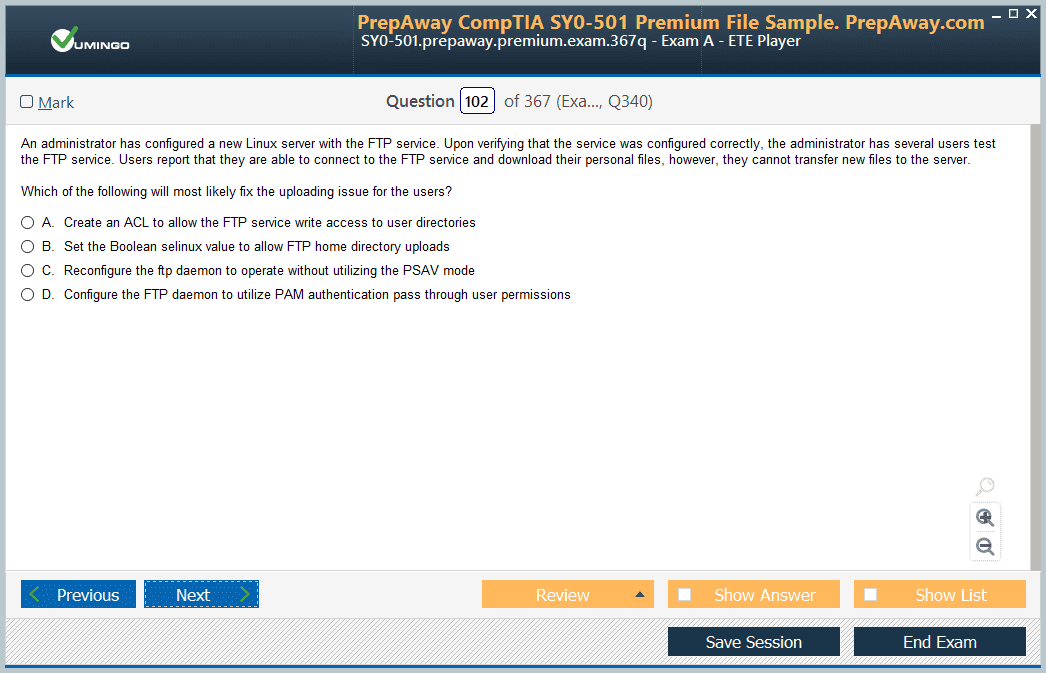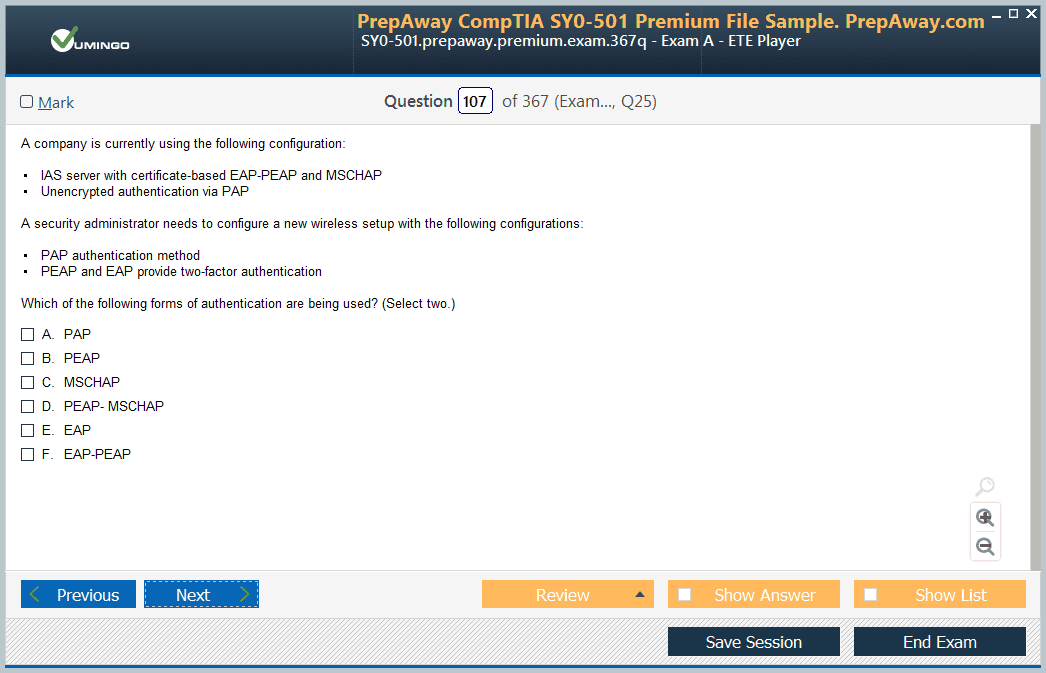- Home
- Amazon Certifications
- AWS Certified Solutions Architect - Associate SAA-C03 AWS Certified Solutions Architect - Associate SAA-C03 Dumps
Pass Amazon AWS Certified Solutions Architect - Associate SAA-C03 Exam in First Attempt Guaranteed!
Get 100% Latest Exam Questions, Accurate & Verified Answers to Pass the Actual Exam!
30 Days Free Updates, Instant Download!


AWS Certified Solutions Architect - Associate SAA-C03 Premium Bundle
- Premium File 675 Questions & Answers. Last update: Dec 18, 2025
- Training Course 368 Video Lectures
- Study Guide 632 Pages
Last Week Results!

Includes question types found on the actual exam such as drag and drop, simulation, type-in and fill-in-the-blank.

Based on real-life scenarios similar to those encountered in the exam, allowing you to learn by working with real equipment.

Developed by IT experts who have passed the exam in the past. Covers in-depth knowledge required for exam preparation.
All Amazon AWS Certified Solutions Architect - Associate SAA-C03 certification exam dumps, study guide, training courses are Prepared by industry experts. PrepAway's ETE files povide the AWS Certified Solutions Architect - Associate SAA-C03 AWS Certified Solutions Architect - Associate SAA-C03 practice test questions and answers & exam dumps, study guide and training courses help you study and pass hassle-free!
Step-by-Step Guide to Passing the AWS Solutions Architect Associate SAA-C03 Exam
The AWS Certified Solutions Architect Associate Exam SAA-C03 is one of the most widely recognized certifications for professionals aspiring to validate their skills in designing and deploying scalable systems on Amazon Web Services. This certification is highly valued across industries because it demonstrates not only technical knowledge but also the ability to apply architectural principles to real-world business challenges. For many professionals, the journey toward becoming an AWS Solutions Architect begins with a clear study path that combines theory, practical labs, and extensive practice.
The SAA-C03 exam requires candidates to show proficiency in core AWS services, security practices, high availability, disaster recovery, cost optimization, and performance efficiency. Unlike other entry-level certifications, this one goes deeper into architectural design and problem-solving. Therefore, preparing for it demands a structured approach where learners gradually build a foundation, advance into service-level expertise, and finally practice exam-style scenarios.
Understanding the study path is essential because AWS is an expansive ecosystem. Candidates often feel overwhelmed by the number of services, features, and design patterns. Without a focused strategy, it becomes difficult to prioritize what to learn and how to align that knowledge with exam objectives. This is why mapping out a systematic preparation plan is the first step toward success.
Overview of the SAA-C03 Exam Structure
The SAA-C03 exam is designed to test real-world skills across multiple domains. It consists of multiple-choice and multiple-response questions that reflect architectural scenarios encountered by solutions architects. Candidates must interpret requirements, analyze trade-offs, and select the best possible solution using AWS services.
The exam typically includes around 65 questions with a time limit of 130 minutes. The scoring system uses a scale ranging from 100 to 1000, with a passing score set at 720. The exam blueprint is divided into four main domains, each with a specific weightage.
The first domain covers design of secure architectures, emphasizing identity and access management, encryption, security controls, and compliance requirements. The second domain focuses on designing resilient architectures, which include fault tolerance, high availability, backup strategies, and disaster recovery. The third domain evaluates knowledge of high-performing architectures, testing whether candidates understand workload optimization, service selection, and performance monitoring. The final domain addresses cost-optimized architectures, where the ability to balance cost efficiency with reliability and scalability becomes crucial.
By familiarizing themselves with this structure, candidates can allocate study time effectively, ensuring they give more focus to high-weight domains while still mastering the entire syllabus.
Importance of Foundational Knowledge
Before diving into advanced study materials, candidates must solidify their understanding of basic cloud concepts. A common mistake is to rush into memorizing exam dumps or practice questions without having a strong foundation in cloud computing principles. AWS services build on these fundamentals, and without a clear understanding, learners risk confusion when faced with architectural design scenarios.
Foundational knowledge includes learning what cloud computing is, the shared responsibility model, the benefits of elasticity and scalability, and the concept of pay-as-you-go pricing. Candidates should also understand global infrastructure, such as regions, availability zones, and edge locations. This knowledge not only supports exam success but also strengthens practical skills when designing systems for real-world clients.
For beginners, exploring the AWS Free Tier can provide hands-on experience. Experimenting with services like EC2, S3, IAM, and RDS at a basic level creates familiarity that later helps with more complex use cases.
Core Services to Master
The SAA-C03 exam places significant emphasis on core AWS services that form the backbone of most architectures. Mastering these services ensures candidates are well prepared for both the exam and practical applications.
Amazon EC2 is one of the most critical services to understand because it provides resizable compute capacity. Candidates must learn about instance types, pricing models, security groups, and scaling strategies.
Amazon S3 is another essential service, widely used for object storage. Knowledge of storage classes, lifecycle policies, bucket policies, and security controls is crucial.
Amazon RDS and DynamoDB represent managed database services. Candidates should be able to design relational and non-relational database architectures, integrate high availability, and ensure security compliance.
Other important services include Amazon VPC for networking, AWS Lambda for serverless computing, Elastic Load Balancing for distributing traffic, and Auto Scaling for adjusting capacity based on demand. Understanding CloudFront for content delivery, Route 53 for DNS management, and AWS IAM for access control further strengthens preparation.
Designing Secure Architectures
Security is a primary responsibility in every AWS deployment, and the exam reflects this priority. Candidates must know how to design systems that protect data, restrict access, and comply with regulations.
Identity and Access Management is the cornerstone of AWS security. Candidates should learn how to create and manage users, groups, roles, and policies. They must understand the principle of least privilege and how to enforce multi-factor authentication.
Data security includes encryption in transit and at rest. AWS Key Management Service and CloudHSM play an important role here. Candidates should know how to design encryption strategies for databases, storage, and application communication.
Network security is another critical aspect. Security groups, network ACLs, private subnets, and VPC endpoints all help restrict unauthorized access. Understanding the difference between public and private networking configurations is key.
Compliance is increasingly important for organizations operating across jurisdictions. AWS provides compliance programs and auditing tools such as AWS Config and CloudTrail. Solutions architects should be comfortable integrating these into architectural designs to meet audit requirements.
Designing Resilient Architectures
Resilience ensures that systems remain functional even during failures. The exam tests whether candidates can design fault-tolerant and highly available architectures.
High availability means distributing workloads across multiple availability zones or even regions. For example, deploying EC2 instances in different zones with a load balancer ensures continuity even if one zone fails.
Disaster recovery strategies range from backup and restore to multi-site active-active designs. Candidates should evaluate trade-offs between cost and recovery time objectives.
Resilient data storage is also critical. S3 provides cross-region replication and versioning, while DynamoDB offers global tables. RDS supports multi-availability zone deployments with automated failover.
Monitoring and automation tools such as CloudWatch, CloudFormation, and Systems Manager help maintain resilience by automating failover and recovery procedures.
Designing High-Performing Architectures
Performance efficiency requires choosing the right resources and services to meet workload requirements. Candidates must understand service limits, scaling options, and performance monitoring.
Compute optimization includes selecting the appropriate EC2 instance family. For example, compute-intensive workloads may require C-family instances, while memory-heavy applications may benefit from R-family instances.
Storage performance is equally important. EBS offers multiple volume types optimized for throughput or IOPS. DynamoDB provides predictable performance with on-demand or provisioned capacity modes.
Networking optimization involves using services like Amazon CloudFront to cache content globally and Route 53 to implement latency-based routing.
Performance monitoring is essential for identifying bottlenecks. AWS X-Ray and CloudWatch metrics provide insights into system health and application performance.
Designing Cost-Optimized Architectures
Cost optimization is a crucial skill for solutions architects. The exam evaluates whether candidates can balance performance and reliability with financial efficiency.
AWS pricing models, such as on-demand, reserved instances, and spot instances, form the foundation of cost optimization strategies. Candidates should know when to use each model depending on workload predictability.
Storage cost optimization requires choosing appropriate storage classes. For instance, frequently accessed data may remain in S3 Standard, while archival data can move to Glacier Deep Archive.
Designing cost-efficient architectures also involves eliminating underutilized resources. Implementing monitoring tools to detect idle resources and automating scaling ensures costs are kept under control.
AWS Trusted Advisor and Cost Explorer provide insights into cost-saving opportunities. Integrating these tools into design practices is a valuable skill for exam candidates.
Study Strategies for SAA-C03
Preparing for the SAA-C03 exam requires discipline and effective study techniques. Candidates should start with the official exam guide to understand the objectives clearly. Creating a structured schedule that balances theory, labs, and practice exams ensures steady progress.
Hands-on experience is non-negotiable. Setting up real AWS environments and experimenting with services solidifies theoretical knowledge.
Practice exams are extremely helpful for familiarizing oneself with question formats and identifying weak areas. However, candidates should avoid memorizing answers blindly and instead focus on understanding why certain options are correct.
Time management is another critical skill. During the exam, candidates must pace themselves to ensure all questions are answered within the allotted time. Practicing under timed conditions builds confidence.
Compute Services in AWS
Compute is the heart of most AWS workloads. Understanding the differences between various compute options is essential for exam success. Amazon EC2 offers virtual servers in the cloud and provides flexibility in terms of instance families, operating systems, and networking configurations. EC2 is often used when applications require operating system-level control, legacy application support, or specialized configurations. Elastic Load Balancing works with EC2 to distribute incoming traffic across multiple instances, improving availability and fault tolerance. Another essential compute service is AWS Lambda, a serverless option that allows developers to run code without provisioning or managing servers. Lambda automatically scales based on the number of requests, making it an excellent choice for event-driven applications. The exam will often test your ability to decide when Lambda is more efficient than EC2. Amazon ECS and EKS provide container orchestration services, with ECS integrating tightly with other AWS services and EKS offering a managed Kubernetes solution. The SAA-C03 exam expects you to recognize when containers are more appropriate than EC2 or Lambda and to design architectures accordingly.
Storage Services for Different Use Cases
AWS provides a wide variety of storage solutions, each with its own performance characteristics and cost structures. Amazon S3 is one of the most fundamental services in the exam. It offers object storage with virtually unlimited scalability and supports multiple storage classes, such as S3 Standard, S3 Intelligent-Tiering, and S3 Glacier. Understanding when to choose each storage class is critical, as the exam may present scenarios requiring cost optimization or high availability. Amazon EBS provides block storage volumes for EC2 instances and is useful for transactional workloads that need persistent,, low-latency storage. Amazon EFS delivers scalable file storage that can be shared among multiple EC2 instances. It is particularly important to understand the differences between S3, EBS, and EFS, as exam questions often ask you to determine the best storage solution based on workload requirements. For long-term archiving, S3 Glacier provides cost-effective storage options, though retrieval times can vary depending on the chosen retrieval tier.
Database Services and Their Role in Architecture
Databases are critical for most cloud applications. The AWS SAA-C03 exam requires an understanding of both relational and non-relational database options. Amazon RDS offers managed relational databases, supporting engines such as MySQL, PostgreSQL, Oracle, SQL Server, and Amazon Aurora. Knowing when to use RDS over a self-managed database on EC2 is a frequent exam scenario. Aurora deserves special focus because of its high performance and compatibility with MySQL and PostgreSQL. Amazon DynamoDB provides a fully managed NoSQL database with single-digit millisecond performance. It is widely used in applications requiring high scalability and low latency. DynamoDB also integrates well with serverless architectures. Another key service is Amazon Redshift, a data warehousing solution optimized for analytics workloads. The exam may test your ability to select between DynamoDB, RDS, and Redshift depending on the nature of the data and workload requirements. It is equally important to know about Amazon ElastiCache, which provides in-memory caching with Redis and Memcached. It is commonly used to improve application performance by reducing database load.
Networking in AWS and Global Infrastructure
Networking plays a central role in AWS architectures. The exam expects you to understand the fundamentals of Amazon VPC, which provides logically isolated networks in the cloud. VPC enables you to configure subnets, route tables, security groups, and network access control lists. A strong understanding of VPC is critical since many exam questions involve designing secure and scalable networks. Elastic IP addresses, NAT gateways, and VPN connections are important concepts when extending on-premises networks into AWS. Another key topic is AWS Direct Connect, which establishes dedicated network connections from on-premises environments to AWS. This service is often highlighted in exam questions that focus on secure, high-bandwidth, and low-latency connections. Amazon Route 53 provides DNS services and routing policies, supporting latency-based routing, weighted routing, and failover. The exam may test knowledge of how Route 53 integrates with load balancers and other AWS services to ensure high availability. Content delivery through Amazon CloudFront is also a key focus area, particularly for distributing static and dynamic content globally with low latency.
Security Services in AWS
Security is one of the most emphasized areas in the SAA-C03 exam. The shared responsibility model is fundamental, as AWS secures the infrastructure while customers secure their data and configurations. IAM is the cornerstone of AWS security. It allows you to manage users, groups, and roles, and to enforce least-privilege access policies. The exam often presents scenarios requiring IAM roles for cross-service access or temporary credentials. AWS KMS enables encryption and key management, ensuring data security for services such as S3 and RDS. AWS Certificate Manager helps manage SSL/TLS certificates, which are critical for secure communications. Security groups and network ACLs play a significant role in controlling inbound and outbound traffic. The exam may present questions requiring you to distinguish between these mechanisms and apply them appropriately. Additionally, AWS WAF and Shield are designed to protect applications against web exploits and DDoS attacks. Understanding how these security services integrate into larger architectures is crucial.
High Availability and Fault Tolerance
Designing for high availability and fault tolerance is a central skill tested in the SAA-C03 exam. AWS achieves resilience through multiple Availability Zones and Regions. Architectures should be designed to withstand failures at different levels. Auto Scaling is an essential service that helps maintain application availability by dynamically adjusting capacity. Elastic Load Balancing complements Auto Scaling by distributing traffic across healthy instances. For storage, S3 provides eleven nines of durability by replicating data across multiple Availability Zones. RDS supports Multi-AZ deployments, automatically failing over to standby instances in case of disruptions. DynamoDB offers global tables for multi-region replication and high availability. The exam often presents scenarios where you must select services that ensure business continuity. It is important to distinguish between disaster recovery strategies, such as backup and restore, pilot light, warm standby, and multi-site active-active, and to understand how AWS services support these approaches.
Monitoring and Logging in AWS
Monitoring and observability are critical for maintaining secure and efficient architectures. Amazon CloudWatch provides metrics, logs, and alarms, helping administrators monitor system performance. CloudTrail records API activity, enabling auditing and compliance. Together, these services provide visibility into AWS environments. The exam expects you to know when to use CloudWatch for operational monitoring versus CloudTrail for auditing. AWS Config allows continuous monitoring of resource configurations and compliance with governance rules. Trusted Advisor provides best practice recommendations for cost optimization, security, and performance. Knowing how to leverage these services to maintain compliance and operational health is important for exam preparation.
Cost Optimization Strategies
Cost optimization is one of the pillars of the AWS Well-Architected Framework, and the SAA-C03 exam includes questions on this topic. Understanding the differences between On-Demand, Reserved, and Spot Instances is critical. Reserved Instances are useful for predictable workloads, while Spot Instances provide significant cost savings for flexible or fault-tolerant workloads. S3 lifecycle policies allow automatic transitions between storage classes, reducing costs for infrequently accessed data. RDS Reserved Instances and DynamoDB Reserved Capacity provide additional cost-saving opportunities. The exam may test your ability to design architectures that balance performance and cost efficiency. Leveraging tagging, budgets, and cost explorer tools also helps monitor and control expenses. Demonstrating knowledge of these cost management practices is essential for success in the exam.
Designing Hybrid Architectures
Many enterprises require hybrid architectures that integrate on-premises infrastructure with AWS. The SAA-C03 exam includes scenarios that test your understanding of hybrid solutions. AWS Storage Gateway provides seamless integration between on-premises environments and AWS storage services. Direct Connect offers dedicated network connections, while Site-to-Site VPN establishes encrypted tunnels. Exam scenarios may involve extending Active Directory to AWS using AWS Directory Service or deploying workloads across hybrid cloud environments. Understanding how hybrid architectures address compliance, latency, and availability challenges is critical for exam success.
Designing Resilient Architectures
Resiliency is one of the cornerstones of AWS solutions. The SAA-C03 exam places significant emphasis on creating systems that can recover quickly from failures while maintaining business continuity. To achieve resiliency, architects must understand the concepts of availability zones, regions, fault tolerance, and disaster recovery strategies. An availability zone is an isolated data center within an AWS region that ensures redundancy. By deploying workloads across multiple availability zones, a system can withstand localized outages. Regions provide geographical separation to support global customers and compliance needs.
Fault tolerance ensures that a system continues to function even when components fail. This can be achieved using load balancers, auto scaling, and multi-AZ deployments. Disaster recovery planning is equally important. Techniques such as backup and restore, pilot light, warm standby, and multi-site active-active configurations are used depending on the organization’s requirements. The exam often includes scenario-based questions where candidates must choose the most cost-effective yet resilient architecture that balances business needs with budget considerations.
Designing High-Performing Architectures
Performance optimization is crucial when building applications in the cloud. The exam requires knowledge of how to select the right compute, storage, and networking services for workloads. For compute, Amazon EC2 instance families provide options tailored for general-purpose, compute-intensive, memory-optimized, storage-optimized, and accelerated computing workloads. Understanding which instance type to choose for specific use cases is essential.
Storage performance is another key factor. Amazon S3 provides high durability and availability, but for low-latency access or frequent transactions, Amazon EBS or Amazon EFS may be better suited. Provisioned IOPS on EBS allows for consistent performance when handling high-demand applications. For databases, choosing between Amazon RDS, Amazon DynamoDB, or Amazon Aurora depends on workload patterns, scalability, and query requirements.
Networking performance can be enhanced through Amazon CloudFront for content delivery, AWS Global Accelerator for optimizing traffic routing, and the use of VPC endpoints to reduce latency and enhance security. Caching mechanisms like Amazon ElastiCache also reduce load on primary databases and improve response times.
Designing Secure Applications and Architectures
Security is a shared responsibility between AWS and the customer. AWS ensures the security of the cloud infrastructure, while customers are responsible for securing their applications and data within the cloud. Candidates must demonstrate knowledge of identity and access management, encryption, monitoring, and network security.
AWS Identity and Access Management (IAM) enables fine-grained access control. Best practices include granting least privilege, rotating credentials, and using roles instead of long-term keys. Multi-factor authentication adds an extra layer of protection.
Encryption is vital for securing data at rest and in transit. AWS Key Management Service (KMS) allows centralized control of encryption keys, while AWS Certificate Manager provides SSL/TLS certificates. For sensitive workloads, services like AWS CloudHSM enable hardware-based key storage.
Network security is enforced through security groups, network access control lists, and private subnets. Monitoring tools like AWS CloudTrail, AWS Config, and Amazon GuardDuty provide visibility into activities and potential threats. The exam often presents scenarios requiring secure architectures that comply with industry standards such as HIPAA, PCI DSS, or GDPR.
Designing Cost-Optimized Architectures
Cost optimization is a core part of cloud architecture. AWS provides flexibility in pricing models, and candidates must know how to select the best options for different use cases. The key pricing models are on-demand instances, reserved instances, spot instances, and savings plans. On-demand instances are best for unpredictable workloads, while reserved instances and savings plans provide discounts for long-term commitments. Spot instances are ideal for fault-tolerant workloads that can handle interruptions.
Storage costs can be reduced by choosing the appropriate tier in Amazon S3, such as S3 Standard for frequently accessed data, S3 Infrequent Access for less accessed data, or S3 Glacier for archival. Lifecycle policies can automatically move data between tiers to reduce costs. Similarly, using Amazon RDS reserved instances or DynamoDB reserved capacity can cut costs for predictable database usage.
Monitoring costs with AWS Cost Explorer and AWS Budgets ensures that spending stays within allocated limits. Architects must balance cost with performance, availability, and security requirements, and the exam frequently tests candidates on selecting cost-efficient designs in scenario-based questions.
Hybrid and Migration Architectures
Many enterprises operate in hybrid environments where workloads run both on-premises and in the cloud. The exam requires an understanding of how AWS services integrate with existing infrastructures. AWS Direct Connect provides a dedicated private connection between on-premises data centers and AWS. VPN connections offer encrypted links over the internet for secure communication.
When migrating workloads to AWS, strategies such as rehosting (lift-and-shift), re-platforming, refactoring, and hybrid deployments are common. AWS Migration Hub, AWS Database Migration Service, and AWS Server Migration Service support these processes. Knowledge of these services is vital to answer exam questions involving migration scenarios.
Hybrid architectures also leverage services like AWS Storage Gateway for connecting on-premises environments with cloud storage. Outposts extends AWS infrastructure to customer premises for workloads requiring low latency or regulatory compliance. Candidates must understand how to design seamless hybrid solutions that ensure data consistency, security, and performance.
Monitoring and Logging Architectures
Visibility into systems is critical for maintaining performance, security, and reliability. Monitoring and logging enable administrators to detect issues early and respond effectively. Amazon CloudWatch provides metrics, logs, and alarms to monitor resources and applications. CloudWatch dashboards can visualize performance data, while alarms trigger notifications or automated responses through Amazon SNS or AWS Lambda.
AWS CloudTrail records API activity, providing an audit trail for security and compliance. AWS Config tracks resource configurations and compliance status over time. Amazon GuardDuty analyzes logs for signs of malicious activity, while AWS Security Hub aggregates security findings across multiple services.
Centralized logging using Amazon OpenSearch Service or third-party integrations allows detailed analysis and troubleshooting. These monitoring and logging capabilities are essential for ensuring compliance and operational efficiency. Exam questions often include scenarios where monitoring must detect anomalous activity or resource misconfiguration.
Serverless Architectures and Event-Driven Design
Serverless computing is an important topic in the exam. AWS Lambda allows code execution without managing servers. Lambda integrates with services such as Amazon API Gateway, Amazon S3, and DynamoDB to create event-driven applications. This model improves scalability, reduces costs, and removes operational overhead.
Event-driven design leverages services like Amazon SNS and Amazon SQS for messaging, and AWS Step Functions for orchestrating workflows. These services allow loosely coupled architectures that can scale independently. Serverless applications are highly cost-efficient since resources are only consumed when triggered by events.
The exam requires candidates to understand when serverless is the right choice compared to traditional architectures, and how to implement it securely and efficiently.
Application Integration and Decoupling
Modern cloud applications rely on integration and decoupling for scalability and reliability. Tight coupling creates dependencies that can lead to failures when one component breaks. To avoid this, AWS offers services that support decoupled architectures.
Amazon SQS provides durable message queues, while Amazon SNS allows broadcasting messages to multiple subscribers. Amazon EventBridge enables event-driven applications with integration across AWS services and third-party SaaS applications. These tools support asynchronous communication, reducing bottlenecks and improving resilience.
API-driven architectures use Amazon API Gateway for creating, securing, and monitoring APIs. Combined with AWS Lambda, this supports microservices-based architectures. For workflow orchestration, AWS Step Functions providess a way to coordinate services without manual intervention.
Exam Strategy for Scenario-Based Questions
The SAA-C03 exam often uses scenario-based questions where multiple answers may seem correct, but only one is the most appropriate given the context. Candidates must carefully read requirements, considering factors such as availability, performance, security, and cost. Eliminating incorrect options requires identifying solutions that fail to meet one or more constraints.
For example, if a question requires minimal downtime during migration, rehosting may not be appropriate, and database migration services with replication should be considered. Similarly, if cost optimization is a priority, reserved instances or serverless may be better than on-demand resources. Practicing with scenario-based questions builds the skill of analyzing trade-offs quickly and accurately.
The Role of Whitepapers and Well-Architected Framework
The AWS Well-Architected Framework provides best practices in five pillars: operational excellence, security, reliability, performance efficiency, and cost optimization. Whitepapers and reference architectures expand on these topics. Candidates should be familiar with the principles outlined in these resources, as they form the foundation of the exam’s philosophy.
The framework encourages regular architectural reviews, the implementation of automation, and the adoption of design principles such as designing for failure and implementing elasticity. By studying these resources, candidates gain insight into how AWS expects solutions architects to approach real-world challenges.
Understanding the Advanced Preparation Phase
Reaching the advanced stage of exam preparation requires more than basic familiarity with AWS concepts. Candidates need a structured approach that integrates both deep technical learning and practical application. The advanced phase focuses on reinforcing knowledge through applied practice, addressing weaknesses, simulating exam conditions, and aligning AWS services with real-world architecture scenarios.
Prioritizing Advanced Topics
While the foundational concepts cover broad AWS services, advanced preparation emphasizes areas that are both challenging and heavily weighted in the exam. Identity and access management, security policies, disaster recovery strategies, hybrid networking setups, cost optimization techniques, and multi-account governance are key areas. Understanding these topics deeply ensures that you are well-prepared for scenario-based exam questions that test your decision-making abilities. Candidates should also focus on concepts like high availability, fault tolerance, and multi-tier architectures.
Practicing with Complex Architectures
One of the most effective ways to strengthen knowledge is to design and deploy complex architectures on AWS. Instead of focusing solely on simple use cases, practice deploying systems that involve multiple services, such as VPC peering, transit gateways, cross-region replication, or multi-account structures. These practical exercises help solidify theoretical understanding and allow you to explore how services interact in real-world scenarios. For example, building a serverless application that integrates Lambda, API Gateway, DynamoDB, and CloudWatch teaches how AWS services create efficient and scalable systems.
Simulating Real Exam Conditions
Advanced preparation involves practicing under exam-like conditions to build familiarity and confidence. Using practice tests and sample scenarios helps identify gaps in knowledge and adapt to time constraints. Allocate time blocks that replicate the actual exam duration and environment, focusing on answering complex scenario-based questions without interruptions. This approach not only improves time management but also helps train your mind to stay calm under pressure. Candidates who simulate exam conditions frequently report increased confidence during the real exam.
Reviewing and Correcting Weaknesses
Every learner has areas of strength and weakness. Advanced preparation is about identifying weak areas and dedicating more time to them. Use feedback from practice tests to recognize patterns in errors. For instance, if networking questions repeatedly pose difficulties, focus on mastering VPC, subnetting, routing tables, and NAT configurations. Reinforcing weak areas ensures a balanced knowledge base, which is critical because the SAA-C03 exam covers a wide range of services and concepts. Ignoring weak points increases the risk of scoring poorly in sections with higher weightage.
Leveraging Whitepapers and Documentation
AWS whitepapers are invaluable for advanced preparation. Documents such as the Well-Architected Framework, Security Best Practices, and Disaster Recovery Strategies provide deep insights into how AWS expects architects to design systems. Reading and understanding these resources enhances conceptual clarity and aligns your preparation with AWS’s recommended best practices. Additionally, reviewing service-specific documentation helps clarify detailed aspects of configuration and use cases that may appear in exam questions. Candidates who thoroughly study whitepapers often find themselves better equipped for scenario-based assessments.
Group Discussions and Study Communities
Collaboration with peers can accelerate the learning process during advanced preparation. Engaging in study groups or online communities allows candidates to share knowledge, exchange exam tips, and discuss complex scenarios. Group discussions encourage critical thinking and expose you to different perspectives on solving architectural problems. Explaining concepts to others also reinforces your understanding, as teaching requires deep comprehension. Participating in study groups can also provide emotional support, reducing the stress of preparing alone for a challenging exam.
Long-Term Benefits of SAA-C03 Certification
The AWS Certified Solutions Architect Associate certification offers numerous long-term career advantages beyond exam success. It validates technical expertise, enhances employability, and demonstrates commitment to professional development. Employers recognize AWS certifications as proof of competence, which can lead to new job opportunities, promotions, or salary increases. For professionals already working in cloud-focused roles, the certification strengthens credibility and provides confidence in managing complex AWS environments. Additionally, the skills acquired during preparation are directly applicable to designing real-world cloud solutions.
Career Opportunities After Certification
AWS certifications are highly regarded across industries. Professionals who achieve the SAA-C03 certification often find opportunities as cloud architects, solutions engineers, system administrators, or DevOps specialists. Companies ranging from startups to multinational corporations actively seek certified AWS professionals to guide their cloud adoption and optimization strategies. The demand for certified architects is consistently high, as businesses prioritize digital transformation and scalable infrastructure. With cloud adoption growing worldwide, certified individuals gain access to diverse career paths with global relevance.
Bridging to Advanced Certifications
The SAA-C03 certification serves as a foundation for higher-level AWS certifications, such as the AWS Certified Solutions Architect Professional, AWS Certified DevOps Engineer Professional, and specialized certifications in security, data analytics, and machine learning. The knowledge gained during associate-level preparation provides a strong base for pursuing advanced credentials. Candidates who continue their certification journey gain deeper expertise and position themselves as leaders in cloud architecture. This progression not only expands technical skills but also enhances career opportunities in specialized domains.
Building Real-World Confidence
Beyond academic preparation, the certification process instills confidence in solving real-world challenges. Designing architectures that meet business requirements, balancing cost and performance, and ensuring security compliance are tasks professionals face daily. The hands-on practice and theoretical grounding from preparing for the SAA-C03 exam prepare candidates to handle these challenges effectively. The certification validates not only technical skills but also the ability to think critically and apply solutions that align with organizational goals.
Importance of Continued Learning
Cloud technology evolves rapidly, and AWS introduces new services and features regularly. Certification is not the endpoint but rather a milestone in a continuous learning journey. Certified professionals must stay updated with AWS innovations and industry best practices to remain effective in their roles. Engaging in continuous education through webinars, updated whitepapers, hands-on labs, and advanced training ensures long-term relevance. Professionals who embrace lifelong learning remain competitive in the fast-changing technology landscape.
Balancing Theory and Practice
An important lesson from advanced preparation is the balance between theory and practical application. While theoretical knowledge is essential for answering exam questions, practical experience provides the context needed to fully understand concepts. Candidates who focus solely on theory may struggle with scenario-based questions that require the application of knowledge. Conversely, those who focus only on hands-on practice without studying exam content may overlook critical details. Striking a balance ensures comprehensive preparation and long-term mastery of cloud architecture.
Developing Problem-Solving Skills
The SAA-C03 exam emphasizes problem-solving within the context of AWS services. Candidates are expected to design solutions that address specific business challenges, such as reducing latency, ensuring data durability, or minimizing costs. Developing strong problem-solving skills involves practicing case studies and analyzing how different AWS services can be integrated to meet requirements. These skills translate directly into workplace scenarios, where cloud architects must often design innovative solutions under constraints.
Conclusion
Advanced preparation for the AWS Certified Solutions Architect Associate exam (SAA-C03) goes beyond memorizing facts. It involves deep engagement with AWS services, consistent practice, exam simulation, and reinforcement of weak areas. Leveraging whitepapers, group discussions, and complex architecture exercises ensures readiness for the exam’s challenging scenarios. Achieving the certification not only validates technical expertise but also unlocks diverse career opportunities, enhances professional credibility, and builds confidence in solving real-world cloud challenges. As technology evolves, certified professionals who continue learning remain valuable contributors to the growing cloud ecosystem. The long-term benefits extend far beyond passing the exam, making the certification a worthwhile investment for aspiring cloud professionals.
Amazon AWS Certified Solutions Architect - Associate SAA-C03 practice test questions and answers, training course, study guide are uploaded in ETE Files format by real users. Study and Pass AWS Certified Solutions Architect - Associate SAA-C03 AWS Certified Solutions Architect - Associate SAA-C03 certification exam dumps & practice test questions and answers are to help students.
Exam Comments * The most recent comment are on top
- AWS Certified Solutions Architect - Associate SAA-C03
- AWS Certified Solutions Architect - Professional SAP-C02
- AWS Certified AI Practitioner AIF-C01
- AWS Certified Cloud Practitioner CLF-C02
- AWS Certified Machine Learning Engineer - Associate MLA-C01
- AWS Certified DevOps Engineer - Professional DOP-C02
- AWS Certified Security - Specialty SCS-C02
- AWS Certified Data Engineer - Associate DEA-C01
- AWS Certified Developer - Associate DVA-C02
- AWS Certified Advanced Networking - Specialty ANS-C01
- AWS Certified Machine Learning - Specialty - AWS Certified Machine Learning - Specialty (MLS-C01)
- AWS Certified CloudOps Engineer - Associate SOA-C03
- AWS Certified SysOps Administrator - Associate - AWS Certified SysOps Administrator - Associate (SOA-C02)
- AWS-SysOps - AWS Certified SysOps Administrator (SOA-C01)
Purchase AWS Certified Solutions Architect - Associate SAA-C03 Exam Training Products Individually



Why customers love us?
What do our customers say?
The resources provided for the Amazon certification exam were exceptional. The exam dumps and video courses offered clear and concise explanations of each topic. I felt thoroughly prepared for the AWS Certified Solutions Architect - Associate SAA-C03 test and passed with ease.
Studying for the Amazon certification exam was a breeze with the comprehensive materials from this site. The detailed study guides and accurate exam dumps helped me understand every concept. I aced the AWS Certified Solutions Architect - Associate SAA-C03 exam on my first try!
I was impressed with the quality of the AWS Certified Solutions Architect - Associate SAA-C03 preparation materials for the Amazon certification exam. The video courses were engaging, and the study guides covered all the essential topics. These resources made a significant difference in my study routine and overall performance. I went into the exam feeling confident and well-prepared.
The AWS Certified Solutions Architect - Associate SAA-C03 materials for the Amazon certification exam were invaluable. They provided detailed, concise explanations for each topic, helping me grasp the entire syllabus. After studying with these resources, I was able to tackle the final test questions confidently and successfully.
Thanks to the comprehensive study guides and video courses, I aced the AWS Certified Solutions Architect - Associate SAA-C03 exam. The exam dumps were spot on and helped me understand the types of questions to expect. The certification exam was much less intimidating thanks to their excellent prep materials. So, I highly recommend their services for anyone preparing for this certification exam.
Achieving my Amazon certification was a seamless experience. The detailed study guide and practice questions ensured I was fully prepared for AWS Certified Solutions Architect - Associate SAA-C03. The customer support was responsive and helpful throughout my journey. Highly recommend their services for anyone preparing for their certification test.
I couldn't be happier with my certification results! The study materials were comprehensive and easy to understand, making my preparation for the AWS Certified Solutions Architect - Associate SAA-C03 stress-free. Using these resources, I was able to pass my exam on the first attempt. They are a must-have for anyone serious about advancing their career.
The practice exams were incredibly helpful in familiarizing me with the actual test format. I felt confident and well-prepared going into my AWS Certified Solutions Architect - Associate SAA-C03 certification exam. The support and guidance provided were top-notch. I couldn't have obtained my Amazon certification without these amazing tools!
The materials provided for the AWS Certified Solutions Architect - Associate SAA-C03 were comprehensive and very well-structured. The practice tests were particularly useful in building my confidence and understanding the exam format. After using these materials, I felt well-prepared and was able to solve all the questions on the final test with ease. Passing the certification exam was a huge relief! I feel much more competent in my role. Thank you!
The certification prep was excellent. The content was up-to-date and aligned perfectly with the exam requirements. I appreciated the clear explanations and real-world examples that made complex topics easier to grasp. I passed AWS Certified Solutions Architect - Associate SAA-C03 successfully. It was a game-changer for my career in IT!













When will we have this exam?
AWS Certified Solutions Architect 2022 - SAA-C03